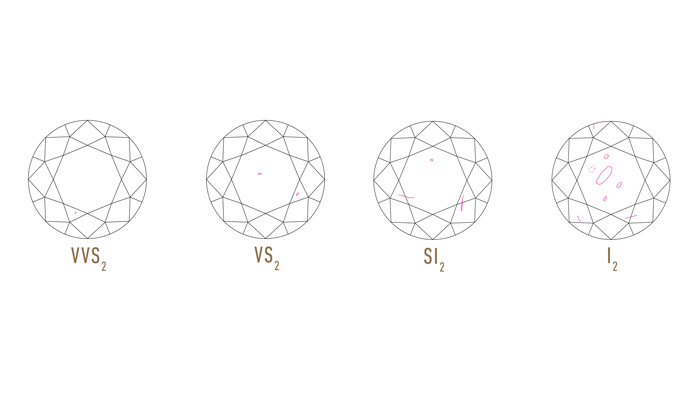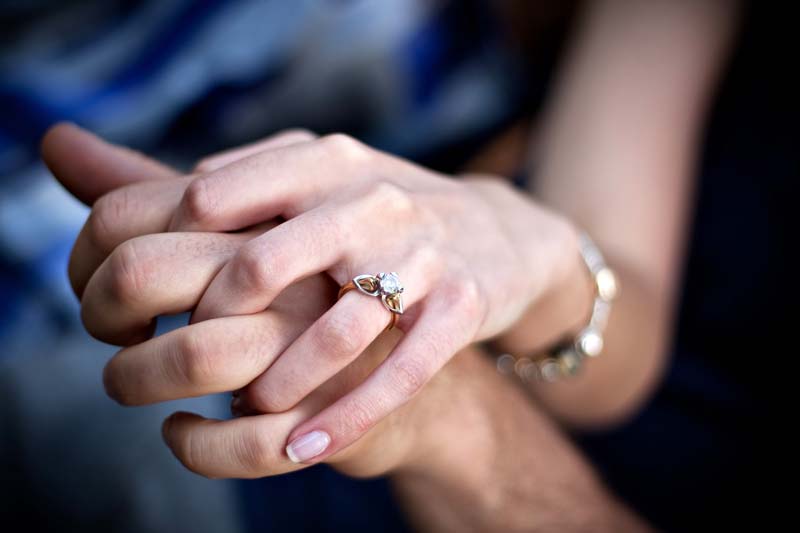While your wedding will be a very special day that you’ll remember forever, your rings are a symbol of your loving marriage that you’ll wear forever. Selecting the perfect ring doesn’t have to be terrifying–it can be thrilling and gratifying. Here the basics:
Buy with your heart
- Buy the diamond that LOOKS the best to you. Let salesmen EDUCATE but not influence you.
- Spend what you feel comfortable spending. Ignore the adage that you’re “supposed” to spend two month’s salary. Spend what feels right.
- Shop around. Look at lots of diamonds before deciding. Learn to spot the difference between an I grade and a K grade.
Diamond quality: Color, Cut, Clarity, and Color
When evaluating a diamond, the experts refer to the “Four C’s”. The basics:
Color: Unless you are shopping for something unusual (like a Canary diamond), the “perfect” diamond will be completely colorless. The Gemological Institute of America (GIA) range of color ratings begins at “D grade” and runs all the way through Z grade (which would be quite yellow). Grades D, E, F are considered “colorless”, Grades G-J are “near colorless”, Grades K, L, M are “faint yellow”, Grades N-R are “very light yellow” and Grades S and lower are considered “light yellow.” Note that some diamonds have a rich bright color and are graded differently.
TIP:
Certain fancy-shaped diamonds hide colour better than others—and can cost up to 25% less than a round-cut diamond. It’s also smart to consider the colour of precious metal for your setting that best compliments the colour grade of your diamond. For example, yellow gold casts a warm glow and looks best with diamonds with faint colour. Platinum or white gold will make a near-colourless diamond look icier.
~Blue Nile
Cut: The cut of the diamond determines how brilliantly the diamond sparkles, because the cut influences how light is reflected inside the diamond (this is different than the “shape” of the diamond, which is the overall appearance). It can be very difficult for the untrained eye to evaluate the detail of the cut, so we recommend buying a diamond with an AGS (American Gem Society) certificate.
Consider an antique diamond cut – find out more here.
TIP:
By far the most popular cut is the Round Brilliant, with it’s fifty-seven perfectly aligned facets it’s brilliance really does out-shine the others. Total internal reflection is the key here; light travels through the stone giving optimum sparkle and scintillation. You can’t go wrong with a round brilliant diamond which will look awesome in any setting; the true classic engagement ring.”
Clarity: The clarity of the diamond refers to the imperfections within the stone. You should look closely at the diamond with a 10x microscope to get a feel for the clarity of the diamond. Nearly all stones have imperfections–the fewer, the more expensive the diamond will be.

TIP:
The GIA Diamond Clarity Scale has 6 categories, some of which are divided, for a total of 11 specific grades.
- Flawless (FL) No inclusions and no blemishes visible under 10x magnification
- Internally Flawless (IF) No inclusions visible under 10x magnification
- Very, Very Slightly Included (VVS1 and VVS2) Inclusions so slight they are difficult for a skilled grader to see under 10x magnification
- Very Slightly Included (VS1 and VS2) Inclusions are observed with effort under 10x magnification, but can be characterized as minor
- Slightly Included (SI1 and SI2) Inclusions are noticeable under 10x magnification
- Included (I1, I2, and I3) Inclusions are obvious under 10x magnification which may affect transparency and brilliance
Source: GIA
Carat: This refers to the size of the diamond, by weight. The larger, the more expensive. Remember that this is only one of many factors that determine the quality and price of the diamond!
TIP:
Carat weight can appear differently across different diamond shapes such as round brilliant, princess, pear, oval, cushion, marquise, emerald, radiant or heart. A diamond may have a higher carat weight without appearing larger and two diamonds of the same carat weight can vary in size if one is cut deeper than the other. In other words, it is important to note that carat weight does not necessarily denote size.
~ Tiffany
Amazon have a very wide selection of high quality, affordable engagement and wedding rings, with great filters to help you find exactly what you’re looking for.
- Click here to see their wedding and engagement collection for women
- Click here to see their wedding and engagement collection for men
Originally written for weddingplanninghints.com.

